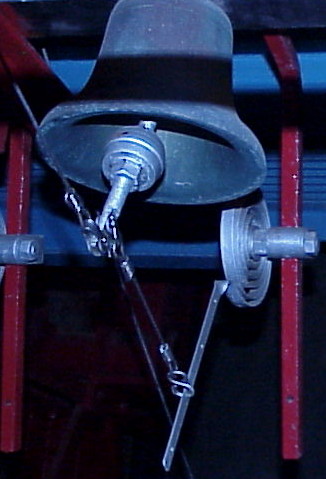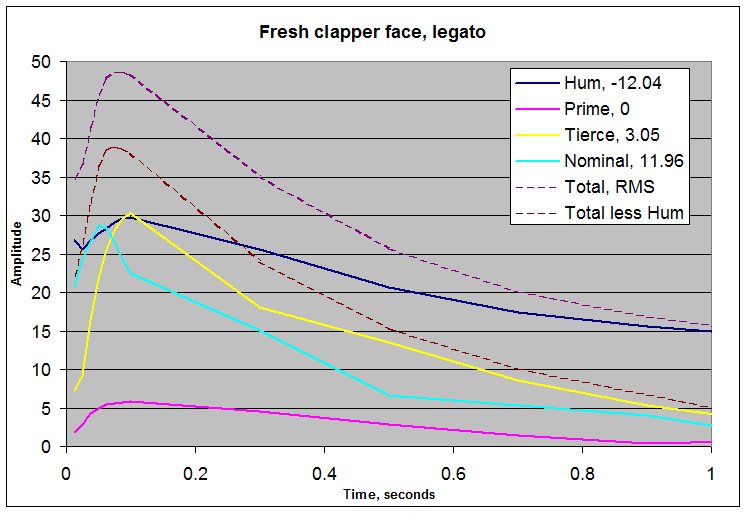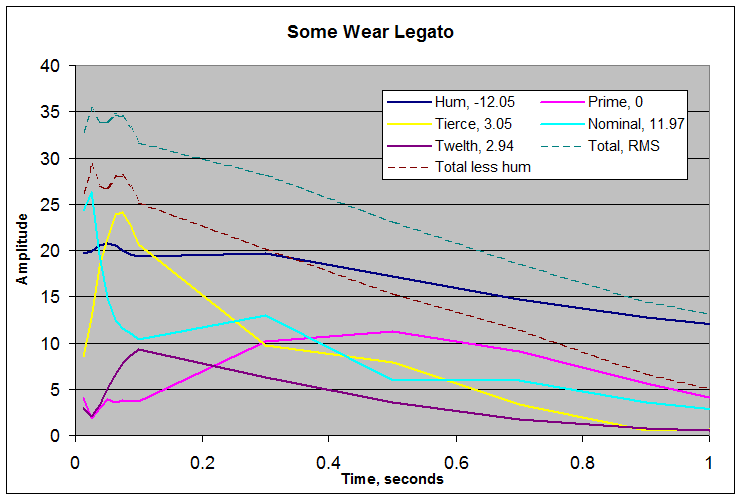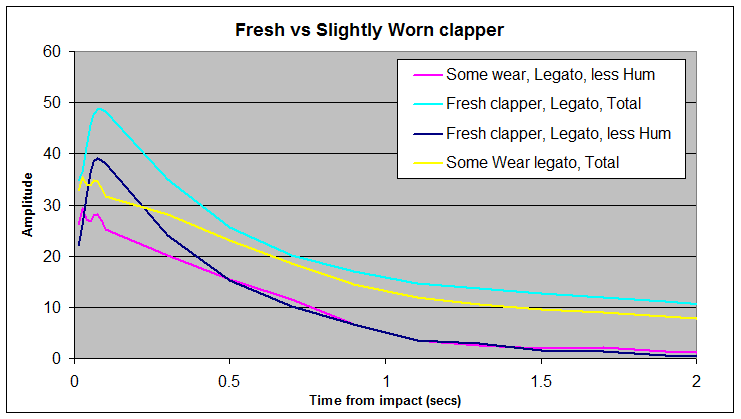Introduction
The comparisons so far
illustrated in this series of articles have involved dramatically
different sounds. We've found them easy to discern by ear, and
easy to discern by analysis. But what happens when we move to a
much more subtle difference. Which gives out first, ear or
analysis?
Our case involves slight wear
in clappers. When clappers are fresh, the sound is full and round.
When clappers are very worn, the sound is painfully harsh. But
what happens when clappers are just a little bit worn? Can we
detect a subtle hardening of the sound? Can we detect that
analytically? What are the first signs a clapper is wearing?
Let's delve!
The experiment
Once more we take advantage of the rotatable clappers at
the Culver Academies carillon. Carillonneur John Gouwens kindly
carried out the test and supplied the recordings. The current
rotatable clappers were installed a few years back and have been rotated
every year since. At the time of the recording, they had had about
six months' wear.
You can see a small strike patch on the face of the
clapper on the image right. The clappers were cast with a raised
equatorial ridge to help keep the contact area small.
John recorded a note on one bell with the clapper
offering its original, slightly worn face, then another note on the same
bell with the clapper rotated to present a fresh face.
Hear the difference
I've taken the recordings of
the two notes and edited them into a convenient comparison, being
careful not to do anything that might alter the sound qualities or level
of either note. You'll hear three strikes on the fresh face,
followed by a pause and three strikes on the slightly worn face.
Fresh vs Some
Wear clappers.mp3
If you're not convinced you
can hear the difference, try listening a few times. I wouldn't
claim the difference is dramatic. If it was, John would have
rotated all his clappers by now!
The Fresh Clapper face
Once again, I'm using Bill
Hibbert's WaveAnal software to do the leg work. The chart below
shows us what it found.

You can see its pretty text book. WaveAnal found only four
partials - Hum, Prime, Tierce and Nominal. The four partials rise
and fall as we have come to expect of a good bell excited by a good,
well-placed clapper. The two dotted lines, Total and Total less
Hum behave in the same way.
The slightly worn face
So now, the big question. Will our analysis show a
different pattern of partials for the admittedly fairly similar sound of
the slightly worn clapper? And the answer is......Yes!
Differences are quite apparent.
Firstly, WaveAnal now detects five partials - the
original four with the addition of the Twelfth (or Upper Quint) partial.
This makes sense. We know that flattened clappers bring out the
upper partials more, so it's logical that slightly flattened clappers
will bring out at least one more. Fortunately, this partial is
harmonic, so it brightens the bell sound without introducing any chaos.
This probably explains why a slightly worn clapper can sound a little
more focussed than a perfectly rounded one, which can sound a little
dull. The downhill slide probably starts when the inharmonic
higher partials are introduced at significant levels.

Secondly, the prominence and decay of the original
partials are altered. The Hum is reduced in level at first, the
Nominal and Tierce decay more quickly, and the Prime takes longer to
establish, but lingers longer.
Finally, the overall decays (Total and Total less Hum)
are less text-book. But, these are still relatively subtle
changes. In other words, they look worse than they sound.
Note, incidentally, the good tuning exhibited by the bell in both cases,
with the Prime spot on, and the worst-case deviation of the other
partials a matter of only 6 cents. Bravo bell tuner!
Comparison
So, let's now compare the
overall bell sounds produced by the two clapper faces, and the overall
bell sounds minus the contribution from the Hum partials.

We certainly seem to be getting a bit more resonance from
the bell just after the strike with the fresher clapper face. But
again, these are minor differences, just made to look large by our powerful
analytical tool. Regard them as being under the magnifying glass - a
distorted view, but one that lets us zoom in on the fine details.
To put that into a mathematical context, note that the
Some Wear totals are about 60% of the height of the Fresh Face totals at
their peak. A drop of 40% in visual terms is a lot, but it's not a
lot in audible terms. Because our ears have evolved to be able to
hear a pin drop but not be deafened by a rifle crack, they are not
sensitive to small changes in level. A 40% reduction is just a
drop of 4.5dB - noticeable, but not dramatic. If the fresh face
had given us a 100dB SPL (Sound Pressure Level) bell strike, then the
Slightly Worn face would reduce that to 95.5dB SPL.
Conclusion
So, yes, we can hear a subtle difference from the
slightly flattened clapper. And yes, we can certainly see those
differences clearly in the analysis. Indeed, we need to be careful
not to read too much into the analyses. Like being frightened by a
nasty looking bug under the magnifying glass. Fortunately, we can
always take advantage of a simple reality check - just listen!
Still, it is encouraging to the analyst that we can detect with ease
things that are close to the threshold of audibility. Better to
have a too-sharp analytical tool than a too-dull one. Do
we need to run these sorts of analyses to check whether its time to
revoice our carillons? Probably not. After all, we don't
revoice our carillons to satisfy the analytical technology, we revoice
them to satisfy listeners. But we do need to counter the fact that
damage to the clappers is incremental, and we become familiar with the
evolving sound and forget the old sound, probably putting off revoicing
longer than we should. Analysis would alert us to that, but so
would comparison with a recording made just after the last revoicing.
We should probably all keep a copy of that reference recording at the
back of the top drawer.
Achnowledgements
Thanks again to John Gouwens for running the experiment
on our behalf, Bill Hibbert for making his bell analysis software
available, and the Audacity team for their so-useful Digital Audio
Editor.
|